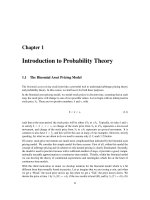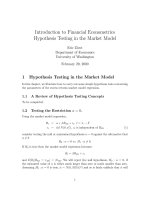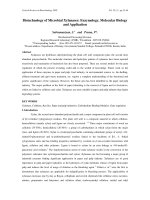Introduction to molecular biology…biology…
Bạn đang xem bản rút gọn của tài liệu. Xem và tải ngay bản đầy đủ của tài liệu tại đây (521.43 KB, 22 trang )
Introduction to molecular
biology…
(…in one hour!!)
Stephen Edwards
Overview
Overview of the cell
Different sizes/functions
Organised structure
Bacterial genetics are different
Eukaryotic cell
DNA
Contained in the nucleus
Arranged in 22 chromosomes, plus two sex
chromosomes
Two copies of each
99.9% identical to other humans, 98% to chimp!
Around 2m DNA, enough to travel to sun and back 600
times!
Therefore, very tightly packed
5' C-G-A-T-T-G-C-A-A-C-G-A-T-G-C 3'
| | | | | | | | | | | | | | |
3' G-C-T-A-A-C-G-T-T-G-C-T-A-C-G 5'
DNA function
Carries the blueprint for life
Duplication for new cells
Make proteins for biological functions:
Gene structure
Genes must have:
– Exons
– Start site
– Control region
mRNA
DNA is grouped into threes (codons)
AGTTTTGGGCCCAAA
Start and stop codons
mRNA is then modified…
…and travels out of the nucleus
mRNA splicing
Alternative splicing
Translation
Uses mRNA as template to make proteins
Occurs in ribosomes
One codon corresponds to one amino acid
Proteins
Huge proportion of cell (after water)
Many functions:
– Structure (e.g. collagen in bone)
– Enzymes
– Transmembrane receptors
– Hormones
Four levels of structure
Protein structure
Protein interactions
Proteins can form interations:
– Proteins (complexes, oligomers)
– mRNA
– DNA
Proteins can bind to each other depending on their
relative charges and structures
Gene expression regulation
Common terminology
Genome/proteome
Genotype/phenotype
Pseudogene
Novel protein/gene
Putative gene
Locus/Allele/Chromosome region
Dominant/Recessive
Homologous
Symbol
cDNA
Motif
Dalton (Da or kDa)
Common abbreviations
EST
SNP
expressed sequence tag
single nucleotide polymorphism
ORF
UTR
open reading frame
untranscribed region
Experimental techniques
Cut, change, knockout genes
Transgenics
Sequence genes and proteins
Over-express proteins
Microarrays
We have used the yeast two-hybrid system to identify proteins that interact with the
intracellular portion of the hepatocyte growth factor (HGF) receptor (Met). We isolated a
human cDNA encoding a novel protein of 68 kDa, which we termed FAP68. This protein is
homologous to a previously described FK506-binding protein-associated protein, FAP48,
which derives from an alternative spliced form of the same cDNA, lacking an 85-nucleotide
exon and leading to an early stop codon. Here we show that epithelial cells, in which the
HGF receptor is naturally expressed, contain FAP68 and not FAP48 proteins. FAP68
binding to Met requires the last 30 amino acids of the C-terminal tail, which are unique to
the HGF receptor. Indeed, FAP68 does not interact with related tyrosine kinases of the Met
and insulin receptor families. FAP68 interacts specifically with the inactive form of HGF
receptor, such as a kinase-defective receptor or a dephosphorylated wild type receptor.
Evidence
In vivo, endogenous FAP68 can be coimmunoprecipitated with the HGF receptor in the
absence of stimuli and not upon HGF stimulation. Thus, FAP68 represents a novel type of
effector that interacts with the inactive HGF receptor and is released upon receptor
phosphorylation. Free FAP68 exerts a specific stimulatory activity toward the downstream
target p70 S6 protein kinase (p70S6K). Significantly, nonphosphorylated HGF receptor
prevents FAP68 from stimulating p70S6K. These data suggest a role for FAP68 in coupling
HGF receptor signaling to the p70S6K pathway.
Future of molecular biology
Personalised medicine
Target-specific drugs (e.g. adipose tissue)
Gene therapy
Comparative genomics
References
Molecular biology information
–
–
–
–
–
–
‘Biology’, Campbell and Reece (6 th Ed.), Very readable general biology textbook
www.ebi.ac.uk/2can, good introduction to bioinformatics and molecular biology
- online biology
book
o, good glossary/information site
/> defines the nomenclature for
human genes
Databases
–
–
–
–
–
–
www.ebi.uniprot.org, excellent protein sequence database
www.ncbi.nih.gov, numerous protein/genome databases
www.ensembl.org, information on genes/proteins/exons of completed genomes
European gene sequence databank
Michael Y. Galperin, The Molecular Biology Database Collection: 2005 update, NAR
www.bioinfo.no/links, list of useful biological links
Gene/Protein naming conventions
–
Bioinformatics. 2005 Jan 15;21(2):248-56. Epub 2004 Aug 27. Gene name ambiguity of
eukaryotic nomenclatures.Chen L, Liu H, Friedman C.
Two hybrid system
![[CEH V3] Introduction to Ethical Hacking](https://media.store123doc.com/images/document/13/ly/ap/medium_3ABUW8WdDH.jpg)








